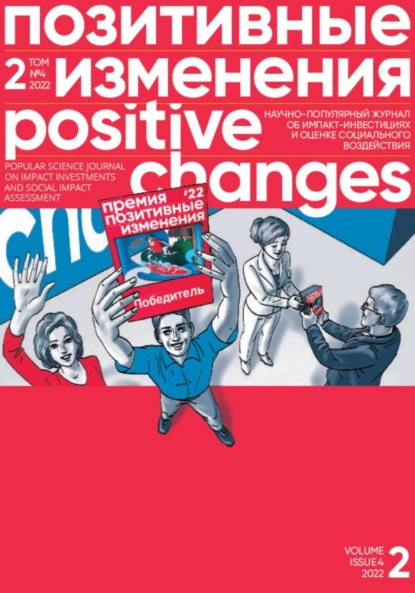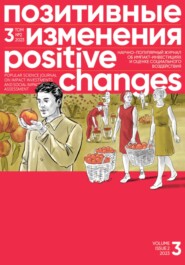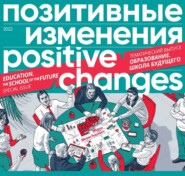По всем вопросам обращайтесь на: info@litportal.ru
(©) 2003-2024.
✖
Позитивные изменения. Том 2, №4 (2022). Positive changes. Volume 2, Issue 4 (2022)
Настройки чтения
Размер шрифта
Высота строк
Поля
WHAT WAS ACCOMPLISHED BY THE END OF 2022?
By the end of 2022, social impact projects were 2/3 of the way through pilot testing scheduled to start from 2019 through the end of 2024. By this point, ten constituent entities of the Russian Federation became actively involved in the design, launch, and implementation of social impact projects, and almost half of the constituent entities expressed an interest in implementing such projects.
Summarizing the results of almost 4 years, the following key achievements can be noted:
• Regulations on the Organization of the Pilot Testing of Social Impact Projects by the Constituent Entities of the Russian Federation in 2019–2024 (Government Resolution No. 1491) were approved, which streamlined the basic requirements for the implementation of social impact projects and launched the pilot testing;
• ten projects were launched in seven constituent entities of the Russian Federation, in five social sectors (education, social services, social protection, health, and employment), with the total investment of 385 million rubles; 419 million rubles were allocated as subsidies from the regional budgets;
• three projects were completed in 2022: one in the Republic of Sakha (Yakutia), in the field of education; and two more in Primorsky Krai, in healthcare and social protection. The total investment in these projects was 106 million rubles, with grants amounting to 114 million rubles. All the projects were deemed a success, as the intended social effect had been achieved;
• social impact projects have gained international recognition: VEB.RF received two ADFIAP awards[53 - Annual award of the Association of Development Financing Institutions in Asia and the Pacific (ADFIAP). The winners are those projects that, in the opinion of the Executive Committee of the ADFIAP Award, make a significant contribution to the specific goal of sustainable development of the national economy.] in 2020 and 2022 for the implementation of social impact projects in education in the Republic of Sakha (Yakutia) and in social protection in Primorsky Krai;
• the methodological support for the implementation of social impact projects was actively developing in 2022, including a redesign and amendments to the VEB.RF website page[54 - VEB.RF (2022). To participants in social impact projects. Retrieved from: https://вэб. рф/agent-pravitelstva/psv/uchastnikam/ (accessed: 10.12.2022).] dedicated to the projects (adding Q&A, information on existing projects, presenting VEB.RF-approved project monitoring procedure and standard forms for launching and implementing social impact projects);
• the Ministry of Finance of the Russian Federation provides methodological support of the social impact projects' implementation, explaining to the constituent entities of the Russian Federation the application of budget legislation during the project implementation.
Diagram 2. Key achievements of social impact projects in 2019–2022
* project numbers determined by the number of project passports approved by the supreme executive authorities of the constituent entity of the Russian Federation as of the end of the respective year
Key achievements of social impact projects broken down by year are shown in Diagram 2.
Behind the dry numbers and facts are tangible social transformations and changes in the quality of life of the citizens of our country. As an example, let's look at the results of three completed projects.
RESULTS OF THE FIRST THREE COMPLETED PROJECTS
The greatest milestone of 2022 was an independent evaluation and the completion of the first three social impact projects. The independent evaluation results act as the basis for the decision to pay the subsidy to the project organizer that was investing in the project in the course of its implementation for it to achieve the social effect. The independent evaluation is also intended to determine the social and economic effects of a project, identify the relationship between project activities and the social effects achieved, and therefore to assess the potential for project scaling.
A project in the sphere of education was completed in the Republic of Sakha (Yakutia). It started in 2019 and was the first social impact project in Russia. The goal of the project was to increase the quality of school education. The project was implemented by the Higher School of Economics, with VEB.DV as the organizer. A special index was developed to evaluate the project success, reflecting the students' test scores in mathematics and the Russian language (8 indicators), the growth in the number of runners-up and winners of the regional stage of the All-Russian School Olympics among 10th and 11th graders (2 indicators). The target is calculated as at least a 10 % increase in all indicators. The detailed index evaluation procedure is attached to the project passport (approved by Resolution of the Government of the Republic of Sakha (Yakutia) No. 150 of June 4, 2019).
The project was designed not only to improve the education level of schoolchildren at the end of the project, but also to consolidate the results to ensure long-term growth in the quality of education in the republic. The first stage was a detailed analysis of schools and students in the pilot area of the project – Khangalassky ulus (district) – so they can be clustered and detailed adapted actions be developed, including individual educational routes. Not only teachers and students, but also parents were involved in the project to ensure sustainability of the results.
One year into the project, restrictive measures related to the COVID-19 pandemic were introduced, which required educational organizations to restructure the educational process to the online format. It turned out, however, that the schools participating in the project were well-prepared for this change, having trialed the online interaction technologies beforehand.
According to the project results, the students' educational performance increased by more than 10 % (in fact – by 41 %), and the educational performance of the students participating in the project also increased by more than 10 % than that of students residing in the two control territories of Yakutia. The number of runners-up and winners of the regional stage of the All-Russian School Olympics from Khangalassky ulus increased significantly in comparison with the start of the project, and one girl won a prize in the final stage of the All-Russian School Olympics on art history for the first time. As a result of the project, seven successful practices were developed for scaling up the activity to all schools in Yakutia, including approaches to the development of school management teams, tutoring and mentoring practices, networking interaction practices between educational organizations, etc.
Two projects were completed in Primorsky Krai – in health care and in social protection, with the participation of Russian Post as the project organizer and implementing partner. Their primary goal was to improve the quality of life in remote areas of Primorsky Krai, where access to social services was restricted. The project passports were approved by Resolution No. 1048-pp and Resolution No. 1049-pp of the Government of Primorsky Krai dated December 18, 2020, scheduling them for implementation from February 1, 2021 to July 31, 2022 (the original deadline of January 31, 2022 had to be extended by six months due to the COVID-19 pandemic), and expansion of the pilot territory. The projects reached over 32 thousand citizens and achieved all their objectives, another proof of the flexibility of the project mechanism.
The healthcare project had two main goals: 1) involve residents in assessment of their health condition as part of the annual clinical examination, and 2) deliver medicines to the home of those residents eligible for additional medical coverage. The first task was complicated by the fact that it first required the engagement of residents who had not attended a checkup for more than two years, as well as due to COVID-19 related restrictions. Despite the challenges, more than 9,000 residents passed medical examinations, with the target figure of just over 5,000. The delivery of medicines required Russian Post to build individual routes for mail carriers and purchase special bags for medicines requiring special storage conditions. As a result, more than 1,300 residents received medications at home; nearly 19,000 deliveries were made, representatives of the authorized organization noted a significant increase in medication shipments, and members of the public left more than 100 positive comments about the project. As a consequence, the delivery of medicines was recorded as a socially significant project for further implementation in Primorsky Krai (Decree of the Primorsky Krai Government No.819-pp of December 2, 2022), which is an example of scaling the practices developed in the framework of the project after its completion.
The second project was dedicated to social protection. Postmen helped identify low-income families living in remote areas for social contracts that would enable them to start their own businesses, develop a smallholding farm, or learn a new profession. The project target was to conclude at least 270 social contracts with low-income families with children[55 - A social contract is a measure of state social assistance for low-income residents to find a job, start their own business and overcome a difficult life situation.] and to identify at least 100 additional low-income families with children.
Diagram 3. Social impact projects: completed projects
The project parameters were determined before the COVID-19 pandemic, so the projected number of low-income families with children was higher than the number of those registered with the social protection agencies. The introduction of additional support measures by the federal and regional government resulted in a massive demand for the support, independently from the project. The number of families with children registered with the social protection agencies as low-income had increased by almost 50 % by January 1, 2021 in the pilot areas of the project. To reduce the risk of missing the project targets, considering the change in external factors, the project duration was extended and its pilot area was increased.
For better results, mail carriers visited more than 13,000 families and surveyed more than 800 families to see if they met the criteria for a social contract. Interestingly, as a result of this massive campaign, the implementation of social support measures also involved other categories of citizens, not originally included in the target audience. Information about more than 100 residents eligible for support in the form of a social contract was submitted for consideration to the social protection authorities to decide; this was an additional effect of the project.
Despite the changes in the implementation conditions, Russian Post managed to identify 114 low-income families with children to receive state support. With the help of Russian Post, 349 social contracts were signed with families with children, which is 29 % above the project's target.
The implementation practice of the first three social impact projects confirms the effectiveness of a flexible approach in social impact projects, allowing the activities to be adapted to the dynamically changing environment. This flexibility requires a high degree of professionalism and involvement from all project participants. However, the results are worth the effort.
PECULIARITIES OF SIP DEVELOPMENT IN RUSSIA
Social impact projects are an adaptation of the SIB tool, so let us consider the peculiarities of social impact project development in Russia compared to the foreign practice. A total of 276 SIBs have been launched worldwide in 38 countries (including Russia), which raised more than $739 million in investment.
In less than 4 years of implementation, 10 social impact projects have appeared in Russia. The figure for the entire world (including Russia) in the same period is 102 SIB projects; that is, Russia accounts for 10 % of all the projects launched during this period. At the same time, if we consider the 5 countries with the greatest number of SIB projects in the first 4 years of implementation, Russia's practice is at a comparable level (Table 1[56 - Government Outcomes Lab. (2022). Impact Bond Dataset. Retrieved from: https://golab.bsg.ox.ac.uk/knowledge-bank/indigo/impact-bond-dataset-v2/?query=&maptype=markers. (accessed 10.12.2022).]).
The average investment in SIB projects is 3.7 million U. S. dollars (about 250 million rubles at the average dollar exchange rate in 2022). The average volume of investment in projects in Russia is 38 million rubles. It is incorrect to compare the average volume directly due to differences in the number of social beneficiaries, areas of project implementation, price levels and other components. At the same time, the average cost of implementing projects may reflect the investors' willingness to fund projects that do not guarantee a return on investment (if the social effect is not achieved).
Table 1. Top 5 countries by the number of SIBs in the first four years of implementation
Source: Compiled by the author on the basis of Impact Bond Dataset
Foreign projects usually have several investors – a sample analysis has shown that about a quarter of all projects have a single investor (including that combining the finances of several persons), about a third of projects have 2–3 investors, and more in the rest of the cases (up to 9 investors in one project). In Russian practice, all projects have a single investor (project organizer, according to the Russian law). The development of tools aimed at the participation of several investors in one project can help to attract new investors and increase the potential volume of investment. Investor involvement can also be synchronized with the corporations' ESG agenda, given the direct focus of social impact projects on the assessment of social effects (for example, the presence of a direct measurable social effect is one of the key principles of VEB.RF's ESG strategy[57 - VEB.RF (2022). ESG strategy. Retrieved from: https://вэб. рф/ustojchivoe-razvitie/esg-strategiya/ (accessed: 10.12.2022)]).
Analyzing foreign practice, it is worth noting the presence of investors regularly contributing to SIB projects. Analysis of the Impact Bond Dataset showed that there are more than 20 investors (from the available list of more than 360 organizations) who have invested in 10 different projects or more. These include social/impact and charitable foundations (e.g., Big Society Capital, with 38 projects), as well as major banks (BNP Paribas, Deutsche Bank), pension funds and insurance organizations.
The average project implementation time in Russia is also different from other countries – 31 months on average (from 18 up to 40 months), compared to 48 months abroad[58 - Government Outcomes Lab. (2022). December 2022 Impact Bond Landscape. Retrieved from: https://golab.bsg.ox.ac.uk/community/news/december-2022-impact-bond-landscape/. (accessed 10.12.2022).]. The increase in project duration can increase the costs of project implementation in terms of subsidy payment to the organizer (investor) if the social effect is achieved, and increases the project risks for all participants. The feasibility of implementing longer projects in the Russian practice requires additional analysis of the pros and cons.
Another peculiarity of the Russian approach is the launch of unique projects that test various technologies and mechanisms of work in the social sphere for further scaling. This goes against the foreign (mainly Western) practice, where similar projects are commonly implemented in different locations; that is, the best practices are replicated. For example, of the 9 projects launched in Portugal in 20202021, 5 are called “Digital school MUDA” and 2 are dedicated to digital literacy in schools (Digital Literacy Schools for the Future). In Russia, for example, there is a practice of launching three projects aimed at the development of assisted living (in the Republic of Sakha (Yakutia), Chelyabinsk Region, Khabarovsk Krai), with different project parameters and implementation features (for example, each project has unique social effects), taking into account the specifics and strategic development objectives of each territory. On the one hand, replication generates statistics on the implementation of similar projects, which allows potential investors to assess the risks of a project and decide whether they want to be involved. On the other hand, the main idea of social impact projects is the uniqueness of the practice tested, which in the future can be scaled to give a multiplier effect.
The Russian approach to SIB implementation corresponds to the model typical of Asian countries. There are a series of publications dedicated to the potential of SIB development, under the common title SIB 2.0[59 - USC Sol Price Center. (2022). Social impact bonds 2.0. Retrieved from: https://socialinnovation.usc.edu/sibs2–0/. (accessed 10.12.2022).]. The Russian and Asian approaches are geared toward the existing bureaucratic mechanisms in a country with high state social expenditures and focus on “greasing the mechanism” (i.e., fine-tuning) for effect when scaling best practices, rather than launching small, hard-to-scale projects that emphasize monetary benefits[60 - Sin, С. (2021). China Watches Neighbours Develop Home-Grown SIBs for Well-Being and Innovation. Retrieved from: https://traverse.ltd/application/files/5416/2141/2935/China_Watches_-_Chih_Hoong_Sin.pdf. (accessed 10.12.2022).].
SUMMARY OF THE RESULTS AS OF THE END OF 2022
The results achieved by social impact projects as of the end of 2022 laid the foundation for the development of the tool and the launch of new projects. We can already talk about the constituent entities of the Russian Federation growing the appetite for the implementation of social impact projects. The successful project launch practice is accumulated, cases are built based on the projects completed, and independent evaluation and scaling practices are established.
The accumulated experience, including that of VEB.RF as the operator of 10 SIPs, will make it possible to develop detailed methodological guidelines for the implementation of social impact projects. To develop the instrument and attract new investors, support measures can be elaborated to reduce the risks for investors. To introduce support measures, it is advisable to conduct a detailed analysis of the social and economic effects of the projects. Key growth points:
• availability of successfully completed projects that have been evaluated and confirmed the achievement of social effects, and are being scaled up;
• the availability of constituent entities of the Russian Federation that already have experience in launching projects and the experience of completed projects, which leads to an increase in the quality and speed of new project development in these regions;
• the development of the ESG agenda in Russia among organizations and constituent entities of the Russian Federation, which prioritizes the achievement of measurable social effects from the implementation of projects.
The practice of implementing social impact projects shows that significant financial investment and costly material and technical facilities are not always necessary to improve the quality of life for the public. Sometimes this can be done by merely introducing new technologies and mechanisms of work in the social sphere.
For the state, such projects allow testing new approaches of work in the social sphere, developed by the non-governmental players, for further scaling and an overall improvement in the quality of public services.
For commercial organizations – project investors (and organizers) – this tool makes it possible to implement their policies of social responsibility and sustainable development by addressing state social problems at the system level, and at the same time with the opportunity to return the investment and generate some profit.
Non-profit organizations can obtain an additional source of funding for their activities, to scale their technologies of work in the social sphere for further development as public services (works).
«Столица района»: соседский центр как ключ к формированию городов и сообществ
Тема соседских центров микрорайонов вот уже более 100 лет находится в фокусе внимания исследователей. В наши дни мы можем снова наблюдать возможный расцвет соседских центров. Передовые девелоперские компании вкладывают социальные инвестиции в этот элемент городской ткани. В этом материале мы отразили вопросы видения соседских центров, их роли и поиск модели развития – то, что необходимо знать, прежде чем начать строить свою «маленькую столицу» района.














